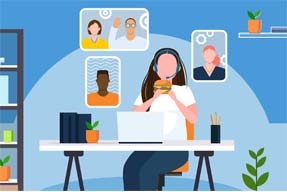A Lunch Box Provided to Employees Working from Home
Most call center agents are still working from their homes due to the Covid epidemic. SQM's experience is that approximately 80% of agents work from home. As a result, one of the biggest concerns that we hear from call center senior leaders is that their agents working from home have a lower emotional connection and engagement with their peers, supervisors, and leaders.
Call centers are famous for having food (e.g., lunch meetings, pot luck, pizza Fridays, candy) provided to agents to create fellowship, engagement, and emotional connection. Unfortunately, due to the Covid epidemic, meetings, lunch, breaks, parties, and celebrations where food was involved in helping enhance and build strong relationships are gone.
Do you have a consistent and effective communication approach for rolling out customer service initiatives? One of the best approaches we have seen is what SQM calls the "meeting with a lunch box" approach. The "meeting with a lunch box" approach allows you to be consistent with your customer service messages while enhancing agent relationships throughout the organization, from one call center to another, from one team to another.

The "meeting with a lunch box" food should be delivered to an agent's house (e.g. Skip the Dishes, Door Dash, Uber Eats), and call center line management share the customer service communication plan with agents via a video call. There tends to be more credibility when call center line management shares the customer satisfaction (Csat) communication plan instead of having a non-call center line manager do so. In addition, call center line management is more committed to understanding and implementing the Csat communication plan when they share it with others. The "meeting with a lunch box" Csat communication plan typically consists of:
- Food Bonding? Employees have a box lunch provided to them, and while eating lunch, leaders share a customer service communication plan through video conferencing (e.g., Teams and Webex).
- What? Explain to all employees what the customer service plan will look like.
- Why? Explain to all employees why you want to implement the customer service plan (e.g., the business case is usually based on your current Csat performance and how you compare to other call centers and opportunities for improvement).
- How? Explain to all employees that the Csat program will be based on customer surveys that will take place within one business day of the customer calling the call center. Employees need to know that they will be held accountable for their Csat performance.
- When? Explain to all employees the start date and that this will be a permanent program (will not be a "project of the year" approach).
- Who? Explain to all employees that everyone from the agent to the VP (e.g., outsourcers) and support departments (e.g., QA, HR, IT, workforce management, training) will be involved in the Csat program.
- Will? Explain what is in it for them (e.g., bonuses, pay increases, promotion, development opportunities, and recognition) linked to the Csat program. Moreover, celebrating agents service heroes who have high Csat.
The "meeting with a lunch box" is an effective approach for helping make an emotional connection with agents while communicating customer service plans or other call center initiatives. Furthermore, the "meeting with a lunch box" delivered to employees' homes will be greatly appreciated by agents, after all, who doesn't like a free meal?

Quick Related Links
First Call Resolution Definition First Call Resolution PPT First Call Resolution Benefits
First Call Resolution Strategies First Call Resolution Operating Philosophy Call Handling Best vs Worst Agents Celebrating Agent Success QA Form Customer Quality Assurance Survey Data Work From Home Agents What is a good FCR Rate? VoC Closed-Loop Top 10 CX Metrics Agent Recognition Case Study Agent Coaching and Recognition

